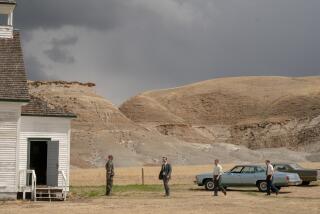Into the Depths
- Share via
The American Cinematheque’s “The Films of Peter Greenaway” opens tomorrow at Raleigh Studios’ Chaplin Theater at 7:15 p.m. with an already sold-out sneak preview of “The Pillow Book.” The film was inspired by the 10th century Japanese diary of imperial court life and centers on a contemporary Japanese woman obsessed with having calligraphy drawn all over her body. It arrives June 6 at selected theaters.
Meanwhile, the Los Angeles premiere of Greenaway’s 1993 “The Baby of Ma^con” screens Friday at 10 p.m. and Saturday at 7:15 p.m., and it should more than satisfy dedicated Greenaway fans, especially admirers of his lurid 1989 “The Cook, the Thief, His Wife and Her Lover,” which closes the series May 17 at 9:30 p.m.
More imaginative and compelling than “The Cook,” “The Baby” becomes even more grisly. Filmed virtually entirely on a huge sound stage, “The Baby of Ma^con” unfolds as a play being staged for 300 aristocrats, including Cosimo de Medici, in 1659 in the Northern Italian town of Ma^con.
In the midst of a plague of famine and infertility, an elderly woman somehow manages to give birth to a healthy, golden-haired baby boy; somehow the baby’s beautiful older sister (Julia Ormond), with money and position on her mind, manages not only to pass herself off as the child’s mother but also convinces people that she gave virgin birth!
The sister, to the increasing chagrin of the church, starts raking in the coins from all those people seeking the infant’s blessing, not only for curing infertility but other ailments as well. All goes well for some time--until the midwife challenges the local bishop’s free-thinking illegitimate son (Ralph Fiennes).
“The Baby of Macon” works, of course, as a parable for human superstition, greed and probably most any other folly you can think of. There’s no denying Greenaway’s formidable skills in mounting a gorgeous, if finally grotesque, period production and in making such a set-bound film seem cinematic. He furthermore gets a heroic and tragic portrayal from Ormond as he deftly blurs the line between the play-within-the-film and an increasingly horrendous reality.
Yet, as with “The Cook,” Greenaway, in turning human degradation into a spectacle, suggests how in reaching for the profound you can wind up with the obvious--and how notions of relationships between life and art, sex and religion, etc., can drown in blood. Most people know all too well the depths of human savagery without having to wallow in it.
The perfect Greenaway film, in comparison, may be his 1982 “The Draughtsman’s Contract” (May 10 at 7:15 p.m.), a stunning blend of his dry-as-dust wit and passion for geometric images. (213) 466-FILM.
Special note: Greenaway will be present for the Friday evening screenings of his films.
*
This weekend brings another film from two other noted intellectuals of the British cinema, Peter Wollen and Laura Mulvey, film theorists who like Greenaway have speculated on the possibilities of the medium. Filmforum will present at LACE Sunday at 7 p.m. their 1983 “The Bad Sister,” a darkly funny take on ‘40s-style psychological melodramas that were as popular in Britain at the time as they were in America.
“The Bad Sister,” an elegant, highly visual work, stars Dawn Archibald as Jane, a film critic living with an obtuse aspiring screenwriter whom she catches in what she regards as a compromising situation with his former girlfriend. The woman’s resemblance to the critic’s half-sister is apparently what plunges Jane into a living nightmare, as memories wash over her of her cruel childhood as the illegitimate daughter of a Scottish aristocrat.
The possibility that the critic has fallen into the evil supernatural thrall of an older woman also looms. Commissioned by Britain’s Channel 4 as its first feature to be shot on video, “The Bad Sister” has as many layers of meaning--including a speculation on a woman’ssense of a divided self--as a Greenaway film. (213) 526-2911.
*
LACMA’s “From Dwan to Siegel: The Bogdanovich Interviews” series offers a terrific Gloria Swanson double feature Saturday at 7:30 p.m. in the museum’s Bing Theater. In “Stage Struck” (1925), one of Swanson and director Allan Dwan’s zesty, timeless collaborations, the actress glows as a naive but plucky waitress in a rowdy river-town restaurant, dreaming of becoming an actress--and of being noticed by the cafe’s handsome flapjack flipper (Lawrence Grey).
Her life and hopes are turned upside down with the arrival of a showboat and its comically vampy leading lady (the peerless Gertrude Astor). “Stage Struck” opens with an eye-popping, two-strip Technicolor daydream in which the waitress envisions herself being acclaimed the greatest actress in the world. Ironically, it could serve as the perfect expression of Norma Desmond’s exalted memory of her stardom--right down to playing Salome.
When Swanson left Paramount for United Artists, she was determined to put her clotheshorse days behind her. It was director Raoul Walsh’s inspired idea that Swanson should do a screen version of Somerset Maugham’s “Rain” (1928), a legendary portrayal of the shady lady stranded in Pago Pago, and she in turn insisted he co-star as Marine Sgt. “Handsome” O’Hara as well as to direct. With her enormous expressive eyes, Swanson is a terrific “Sadie Thompson,” the good-time girl who has fled San Francisco, where clearly she worked as a prostitute, for reasons she would rather not reveal. Her Sadie, vulnerable beneath a breezy, uninhibited facade, is a triumph of subtle yet wide-ranging silent-screen acting, and Walsh’s virile O’Hara is a perfect foil, as is Lionel Barrymore’s remorseless, spirit-crushing Rev. Davidson. Sadie shows Swanson at her sexiest, free at last from the heavy makeup and bizarre trains and headdresses of her De Mille period. (213) 857-6010
*
The UCLA Film Archive’s “The Illustrious Corpses of Francesco Rosi,” a survey of the work of the major Italian director, begins Sunday at 7:30 p.m. in Melnitz Hall’s James Bridges Theater with the screening of “Salvatore Giuliano” (1962), a great, grim movie that cuts to the heart of a proud, primitive people.
In pursuit of the truth of the famed bandit whose seven-year reign of terror ended in the assassination in 1950, Rosi lays bare the poverty, ignorance and feudalism that has long enslaved Sicily. In death as in life, Giuliano remains a man of mystery. Eschewing romanticism, Rosi presents the claims of everyone who knew him without taking sides. His main concern is not the bandit but the oppressive and corrupt conditions that allowed him to flourish in the first place. As detached in tone as a documentary, the film becomes as deeply involving as a detective mystery that culminates with the impact of classic tragedy. Rosi will appear in person. (310) 206-FILM.
*
Note: The American Cinematheque is screening tonight the University Film & Video Assn. Festival, composed of two different programs, screening at 7:15 and 9:45 p.m. Both programs include lively, engaging work. (213) 466-FILM.
More to Read
The biggest entertainment stories
Get our big stories about Hollywood, film, television, music, arts, culture and more right in your inbox as soon as they publish.
You may occasionally receive promotional content from the Los Angeles Times.










